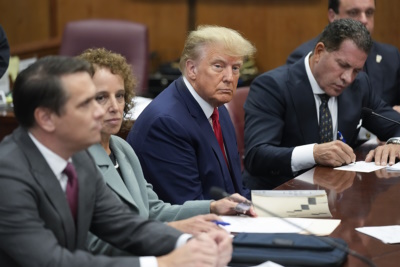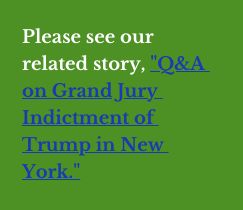The unsealed 16-page indictment against Donald Trump accuses the former president of 34 felony counts of falsifying business records, but it is the accompanying 13-page “Statement of Facts” released by the Manhattan district attorney that gets to the heart of the case.
In it, Manhattan District Attorney Alvin Bragg details the allegations that the falsified business records were meant to conceal hush money payments to three people alleging extramarital affairs by Trump, and makes a case that the payments were made to illegally help Trump’s presidential campaign.
Trump was arraigned on the charges in Manhattan criminal court on April 4, and he pleaded not guilty to all of the charges.
Update, May 30: Trump was found guilty on all 34 counts.
The Indictment
The charging indictment itself is short on the specifics of the case.
As we said, it lists 34 counts of violating New York state law by falsifying business records in the first degree, a Class E felony. The language of each count is nearly identical, accusing Trump of making false records “with intent to defraud and intent to commit another crime and aid and conceal the commission thereof.”
Of the charges, 11 counts are related to invoices filed by former Trump attorney Michael Cohen; another 11 counts are related to checks issued from Trump accounts or trusts; and the other 12 counts are related to voucher entries in the “Detail General Ledger for Donald J. Trump.”
Each of the records was made in 2017 and was “kept and maintained by the Trump Organization,” according to the indictment.
“For nine straight months, the defendant held documents in his hands containing this key lie, that he was paying Michael Cohen for legal services performed in 2017,” Bragg said in a press conference after the arraignment. “And he personally signed checks for each of these nine months.”
Statement of Facts
In addition to the indictment, Bragg released a 13-page “Statement of Facts” that laid out the details and legal basis for the charges brought against Trump.
In New York, in order for the charge of falsifying business records to be bumped up to a felony, one must commit the crime of falsifying business records when the “intent to defraud includes an intent to commit another crime or to aid or conceal the commission thereof.”
And how Bragg got there is summarized in the first two paragraphs of the document.

“The defendant DONALD J. TRUMP repeatedly and fraudulently falsified New York business records to conceal criminal conduct that hid damaging information from the voting public during the 2016 presidential election,” the statement reads.
“From August 2015 to December 2017, the Defendant [Trump] orchestrated a scheme with others to influence the 2016 presidential election by identifying and purchasing negative information about him to suppress its publication and benefit the Defendant’s electoral prospects,” according to the statement. “In order to execute the unlawful scheme, the participants violated election laws and made and caused false entries in the business records of various entities in New York. The participants also took steps that mischaracterized, for tax purposes, the true nature of the payments made in furtherance of the scheme.”
According to Bragg, who spoke in a press conference after the arraignment, in the run-up to the presidential election, Trump, Cohen and David Pecker, CEO of American Media Inc., cooked up a scheme to “catch and kill” damaging stories “to help Mr. Trump’s chance of winning the election.”
The first such case arose in the fall of 2015 when Pecker learned that a former Trump Tower doorman “was trying to sell information regarding a child that the Defendant [Trump] had allegedly fathered out of wedlock.” Pecker paid the doorman $30,000 to kill the story, though he later tried to release the doorman from the agreement after he “concluded that the story was not true.” According to the statement, Cohen instructed Pecker not to release the doorman from the agreement until after the presidential election.
A second case arose in the summer of 2016 when Karen McDougal, a former Playboy model, claimed she had an extended affair with Trump that began in 2006. In McDougal’s case, American Media Inc., which at the time published the National Enquirer, admitted in a plea agreement that it paid McDougal $150,000 in cooperation with the Trump campaign to bury the story.
According to the Statement of Facts, in September 2018, “AMI entered into a non-prosecution agreement with the United States Attorney’s Office for the Southern District of New York in connection with AMI’s payoff of Woman 1 [McDougal], admitting that ‘[a]t no time during the negotiation or acquisition of [Woman 1’s] story did AMI intend to publish the story or disseminate information about it publicly.’ Rather, AMI admitted that it made the payment to ensure that Woman 1 ‘did not publicize damaging allegations’ about the Defendant ‘before the 2016 presidential election and thereby influence that election.’”
Finally, just a few weeks before the election, yet another woman “alleged she had a sexual encounter with the Defendant [Trump] while he was married.” That woman was porn star Stormy Daniels, whose real name is Stephanie Clifford. According to the statement, “with pressure mounting and the election approaching,” Trump agreed to pay Daniels $130,000 in hush money.
“This payment was illegal, and Lawyer A [Cohen] has since pleaded guilty to making an illegal campaign contribution and served time in prison,” the statement says. “Further, false entries were made in New York business records to effectuate this payment, separate and apart from the New York business records used to conceal the payment.”
In August 2018, Cohen pleaded guilty to two campaign finance law violations and admitted in open court that he paid $130,000 to Daniels to silence her during the 2016 presidential election “at the direction of” Trump.
Trump’s subsequent reimbursements to Cohen in 2017, recorded in business records as legal expenses, are the basis of the 34 counts in the indictment.
“Under New York state law, it is a felony to falsify business records with an intent to defraud and intent to conceal another crime,” Bragg said in the press conference after the arraignment. “That is exactly what this case is about.”
“Why did Donald Trump repeatedly make these false statements? The evidence will show that he did so to cover up crimes relating to the 2016 election,” Bragg said.
Tying the false statements to alleged election law crimes underpins Bragg’s case to elevate the crimes to felonies.
“The participants’ scheme was illegal,” Bragg said. “The scheme violated New York election law, which makes it a crime to conspire to promote a candidacy by unlawful means. The $130,000 wire payment exceeded the federal campaign contribution cap. And the false statements in AMI’s books violated New York law. That is why Mr. Trump made false statements about his payments to Mr. Cohen.”
Although Trump and his attorneys have claimed the prosecution is politically motivated and would not have been pursued against anyone other than Trump, Bragg said his office has “charged hundreds of felonies for falsifying business records. This charge, it can be said, is the bread and butter of our white collar work.”
Editor’s note: FactCheck.org does not accept advertising. We rely on grants and individual donations from people like you. Please consider a donation. Credit card donations may be made through our “Donate” page. If you prefer to give by check, send to: FactCheck.org, Annenberg Public Policy Center, 202 S. 36th St., Philadelphia, PA 19104.
